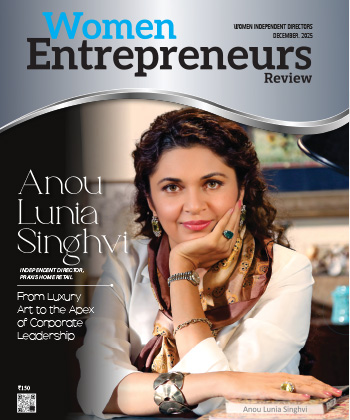
How to Build Dynamic Teams & Navigate Leadership Challenges
By: Pooja Sanghvi, CFO & Finance Director, Jotun
Pooja Sanghvi has more than 12 years of diverse experience spanning FMCG, infrastructure, IT, retail, and services. Her expertise extends across P&L turnaround, accounting, financial planning, business partnership, strategy, MIS, financial modeling, and business IT developments.
Here is what she says about building a winning team and facing any challenge as a leader.
As I think of what can best explain how to build an excellent team and navigate leadership challenges, this verse from Rudyard Kipling’s 'If' comes to my mind…
“If you can make one heap of all your winnings,
And risk it on one turn of pitch-and-toss,
And lose, and start again at your beginnings,
And never breathe a word about your loss”
A beautiful reminder of life's ebb and flow, akin to leadership. My journey has been marked by opportunities to work with some great leaders who are also my mentors now. One of my mentors introduced me to the concept of knowing yourself through the people you work with. He is the reason I have been vocal about team building, working with diverse people and navigating my way across the leadership journey.
When I first took over a team management role, he introduced me to the book ‘Good to Great’. This is a manual on building anything that you imagine with a solid foundation. I am sharing with you some of my learnings along with the book to give you a flavour on what I believe is a sure shot way to get the recipe smoothly. In this book, Jim Collins, personifies a bus to represent an organisation and its values. A brilliant mantra he gives here is ‘First Who, Then What. Get the right people on the bus. Make sure you have the right people on the bus and the right people in the key seats before you figure out where to drive the bus. It requires courage and conviction in your ethos to follow this route. The next thing one should always take care of is spending time while hiring than managing. Focus on getting the right people on board the bus. Talented individuals who share the same values and commitments are essential for the success of the team. Constant messaging and sharing your vision with them is a what keeps the team focussed and together. A good leader doesn’t draw boundaries to work. This helps the team discover their potential, their interests beyond their expertise and push it exponentially. There is enough space given for doing things first time right. The team knows that there are multiple ways of solving a problem and they are empowered to think about long term scalable frameworks. Young teams also know that it’s the outcome that matters, not the hours put in and definitely not the optics. Such a team is driven by value, not just activity; focused on delivering to agreed time frames and looking for ways to optimize both. It does whatever it takes to meet and/or exceed its leader’s expectations.
Connecting with teams on aspects of life beyond work is a great way to understand their pressure threshold. You want people to challenge the status quo. To be authentic in ways they deal with a challenge. These are people who do not make excuses, do not avoid challenges. This expects you also to be authentic.Giving your team a perspective that they represent the organisation, be it with internal or external stakeholders is a key to setting the tone right.
I have observed great leaders practicing empathy and tough love as the situation needs. Reminds me of a very meaningful belief engraved in my head, that no one comes to work thinking they are going to do a bad job. This mantra has helped me get clarity on many ‘whys’ and navigate through intense situations.
There is enough said on having your team’s back and making sure you are approachable to them. Being approachable isn't just an open-door policy; it's leaving every interaction with the team enhanced – happier, wiser, or more confident. The journey is gradual, taking months to forge a cohesive team.
Your trusted bus is finally ready to start. The trust that you build over time helps you build your brand. People around you know what you stand for; that your bus is solid.That helps grow your network and your influence. Building allies in your stakeholders always helps conflict management.
An exercise I do in every role that I take up is stakeholder mapping. A starting point is understanding who is impacted, when and aligning their interests with yours and the organisation. Simplifying everything that comes your way consistently keeps everyone drawn to the vision you want to drive. This can help you cut the noise and focus even better.
Getting better than your previous self is your goal. The farther you improve, the bigger the effort in incremental improvement. At times when it seems dark, grit and resilience will let you be authentic. Remember, it is a marathon, not a sprint. Facing criticism comes as a biproduct to leadership roles. The harder you make an impact, the stronger is the criticism. Self-respect over popularity is a mantra that comes handy in successfully overcoming such phases. More often than not, succeeding is all about how you’ve defined success and what you begin contributing to the world…As my journey continues, the essence encapsulated in the closing lines of Kipling's 'If' resonates deeper
“If you can fill the unforgiving minute
With sixty seconds’ worth of distance run,
Yours is the Earth and everything that’s in it,
And—which is more—you’ll be a Man, my son!”
My purpose is connecting talent with roles in the modern workplace. Reach out, share your journey, and let's drive our buses together. Happy to help. Take care and keep steering your bus.
These words are my personal perspective and do not reflect the views or opinions of any organization or workplace I am affiliated with.
Most Viewed
- 1 Women's Health Startup HerMD Closing Doors Amid Industry Challenges
- 2 5 Famous Women in Indian Armed Forces
- 3 Saudi Women No longer Require Male Permission for Clothing Choices, says Prince MbS
- 4 Kolkata Medtech Startup Innovodigm Raises Rs 5.5 Crore Seed Funding Led by IAN Group
- 5 Yamunanagar's Kashish Kalra Honoured after Securing 111th Rank in UPSC Civil Services Exam
- 6 Madurai Appoints Its First Woman Corporation Head
- 7 IAS Vijayalakshmi Bidari Appointed as the new Nagpur Divisional Commissioner
- 8 American Entrepreneur Lucy Guo Overtakes T Swift to become Youngest Female Billionaire
- 9 ICC Women's World Cup 2025 Trophy Showcased at Indore's Holkar Stadium
- 10 Aparna Saxena's Beauty Venture AntiNorm Launches in India
- 11 Vidya Nataraj Co-Founded BlueStone Jewellery & Lifestyle files IPO
- 12 5 Women Freedom Fighters of India
- 13 Dr. G Krishnapriya appointed as CEO for Trichy
- 14 M3M & Sirona Partner to Introduce Menstrual Hygiene Vending Machines in 15 Locations
- 15 Punjab Govt launches SHE Cohort 3.0 Supporting Tech-led Women Startups
- 16 Indian origin Lawyer, Sweena Pannu appointed as the US New Superior Court Judge
- 17 The Aurora Tech Award recognizes 4 Indian Women-led Startups
- 18 Kerala's Republic Day parade featured an all-female tableau
- 19 Manisha Kabbur Becomes Karnataka's First Woman International Karate Coach
- 20 Director K. S. Ravikumar's Daughter Maalica Ravikumar Launches Life Coaching Company 'Evergrowth Academy' for Women
- 21 Leezu's Raises Pre-Seed Funding to Accelerate Growth in Sexual Wellness Industry
- 22 Sattu: Super-easy summer drink for PCOS gut healing
- 23 Swathi Nelabhatla creates Sitha App, India's First Women-Exclusive Gig Platform
- 24 7 Timeless Female Kathak Dancers & their Iconic Legacies
- 25 Meet 7 Iconic Women Architects of Modern India & their Most Impactful Work
- 26 This Woman-led Insuretech Startup is Helping Bridge the Education Financing Gap in India
- 27 Women Leaders Share Lessons Learnt from India Women's WC Win
- 28 5 Enterprising Women Founders Powering Singapore's Tech & Innovation Landscape
- 29 4 Women. 4 Stories. One Vision for Smarter, Stronger Healthcare
- 30 Global Gender Gap Narrows to 68.8%, But Full Equality 123 Years Away: WEF Report 2025
- 31 Changemakers: 7 Women Entrepreneurs Taking the Make in India Movement Forward
- 32 Meet Lucy Guo, The Youngest Self-Made Female Billionaire Disrupting Tech
- 33 How Women are Driving India's Festive Online Shopping Surge






